Key takeaways:
- Curriculum revision fosters engagement and critical thinking, requiring collaboration among educators, students, and parents to ensure relevance and inclusivity.
- Religious education cultivates mutual respect, empathy, and ethical values by integrating diverse perspectives and real-life scenarios into discussions.
- Assessing curriculum effectiveness involves gathering feedback, analyzing student performance, and aligning content with contemporary cultural contexts.
- Future goals for religious education focus on promoting interfaith dialogue, utilizing technology, and encouraging critical thinking about faith-related issues.
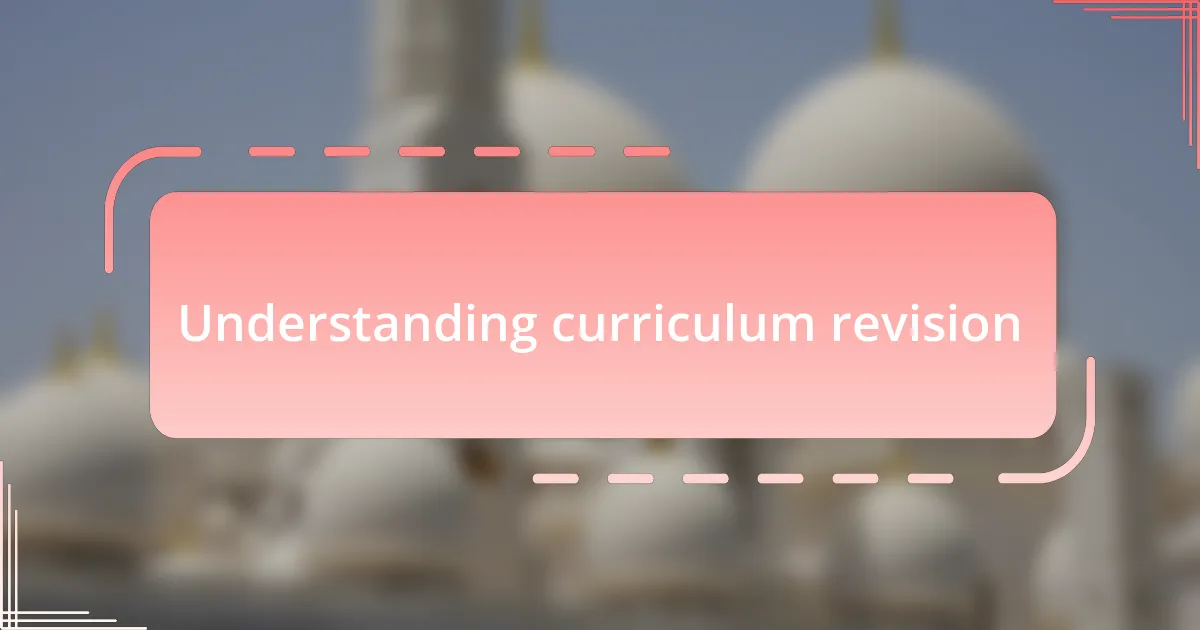
Understanding curriculum revision
Curriculum revision is a dynamic process that involves assessing and updating educational content to ensure it meets the needs of students and the evolving context of society. I remember when we undertook a major revision in my own teaching experience; it felt daunting at first, but soon it became clear how essential it was to engage our students meaningfully. Have you ever considered how stagnant curricula can lead to disengagement?
An effective revision requires collaboration and input from various stakeholders, including educators, students, and parents. I vividly recall a workshop where teachers brainstormed ideas together—those lively discussions were a goldmine for insight! What struck me was how different perspectives enriched the conversation and led to more holistic improvements. It raised the question: how often do we actively seek diverse voices in our curriculum development?
Moreover, understanding the rationale behind curriculum changes is crucial. It’s not just about updating facts or figures; it’s about fostering critical thinking, empathy, and connection to the world. During one particular revision, we shifted our focus to include more global religious perspectives, which opened up profound discussions among students. Isn’t it inspiring to think that curriculum revision can empower students not just academically but also personally?
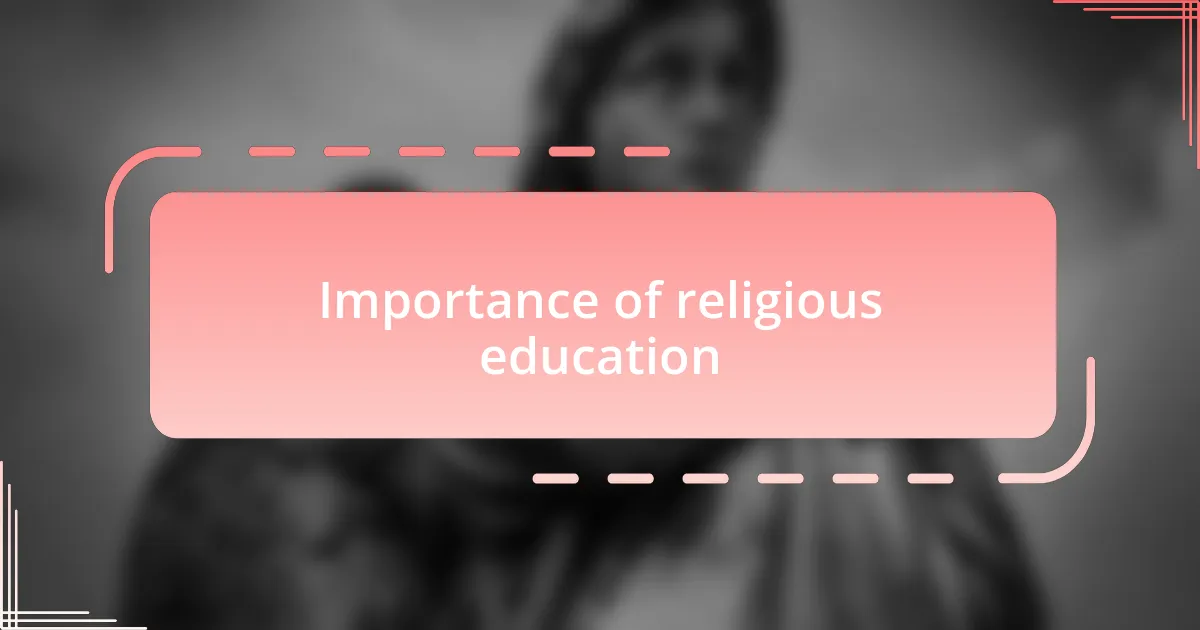
Importance of religious education
The importance of religious education cannot be overstated. In my experience, it provides students with a framework for understanding their own beliefs and those of others, fostering mutual respect and dialogue. I often reflect on a student who once expressed his newfound appreciation for different faiths after participating in a project comparing religious texts; it was a moment that highlighted the power of education in bridging divides.
Religious education also plays a crucial role in cultivating moral values. I remember discussing ethical dilemmas in class, where students debated concepts like compassion and justice as framed by various religious traditions. Have you ever noticed how students become more empathetic when they relate moral teachings to real-life scenarios? It’s remarkable how these discussions can spark a transformation in their worldview.
Additionally, integrating religious education nurtures critical thinking skills. I’ve seen firsthand how students learn to analyze and question beliefs not only in a theoretical context but personally as well. Engaging with different faith perspectives often leads them to challenge their assumptions. Isn’t it fascinating how such exploration can empower young minds to think deeply about their values and the world around them?
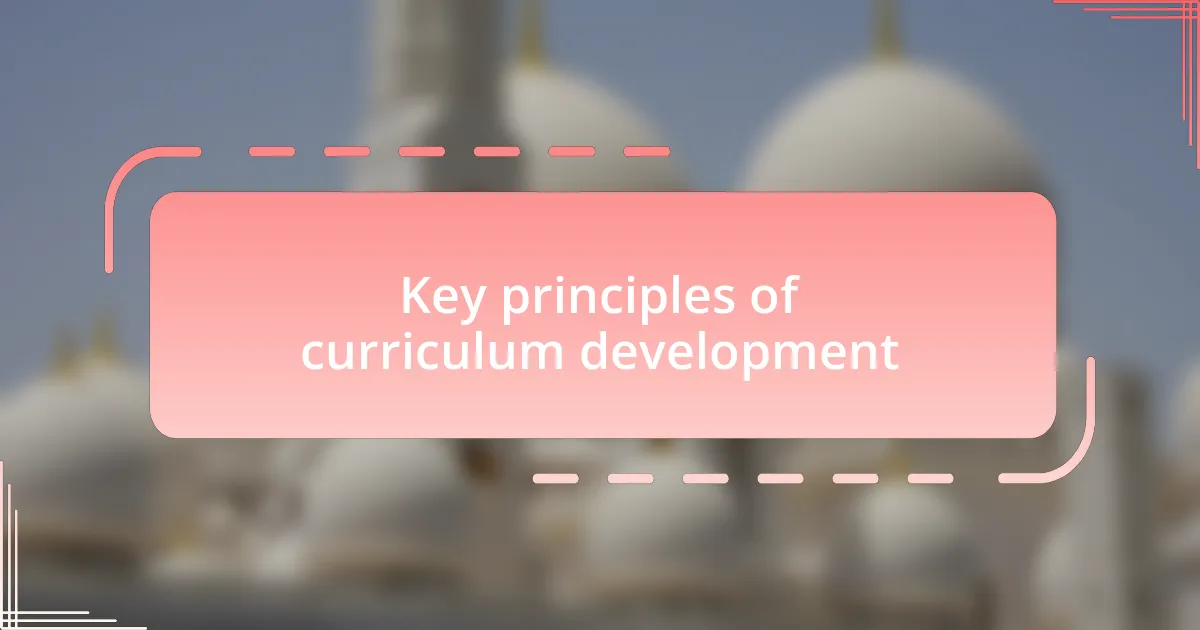
Key principles of curriculum development
Key principles of curriculum development revolve around alignment, inclusivity, and relevance. From my perspective, ensuring that the content aligns with educational standards and assessment methods is vital for creating a coherent learning experience. When I first designed a curriculum unit on world religions, I quickly learned that putting this principle into practice meant adjusting lessons to meet both state guidelines and the diverse needs of my students.
Inclusivity is another cornerstone of effective curriculum development. I vividly remember a time when I included perspectives from lesser-known religious traditions, which sparked vibrant discussions in my classroom. Have you ever seen students light up when they discover their own culture reflected in their studies? That sense of belonging can indeed deepen their engagement and understanding.
Lastly, relevance cannot be underestimated. When I incorporated contemporary issues, such as interfaith dialogues and current events impacting religious communities, students showed increased interest in the material. It’s rewarding to see how connecting lessons to their lives and realities makes the content more meaningful. Isn’t it amazing how students thrive when they see the direct impact of what they’re learning?
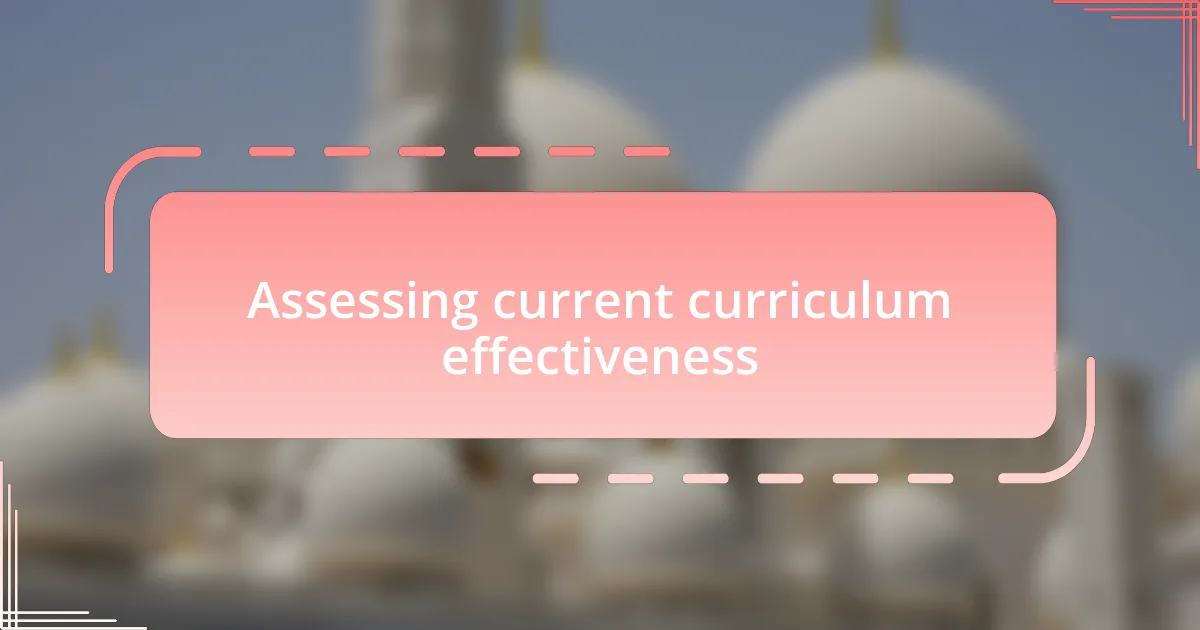
Assessing current curriculum effectiveness
Assessing the effectiveness of the current curriculum involves a critical look at how well it meets student needs and educational goals. I recall an instance where I evaluated a unit on ethical teachings across different religions and noticed that some students struggled to connect with the material. This made me realize the importance of gathering feedback through assessments and discussions to fine-tune our approach, ensuring every voice is heard.
Another key factor is analyzing how well the curriculum aligns with the evolving cultural and social contexts. I once discovered that students were more engaged when we addressed topics like religious pluralism relevant to our community. This experience taught me that regularly revisiting and revising curriculum content based on current events not only enhances understanding but also fosters a classroom environment where students feel their perspectives matter.
Finally, examining assessment results can reveal a lot about curriculum effectiveness. I remember receiving test scores back from a module on Hinduism and realizing that the majority of my class had underperformed. This prompted me to rethink my teaching strategies and materials, emphasizing adaptability in my teaching to better support my students’ learning journeys. Have you found that re-evaluating assessments has shifted your curriculum approach as well?

Personal experiences with curriculum change
Experiencing curriculum change firsthand has been both a challenge and an opportunity for growth in my teaching journey. When our religious education curriculum was updated to include more contemporary religious issues, I felt a mix of excitement and apprehension. I vividly remember the first lesson after the change; my students were engaged, posing thoughtful questions about social justice in various faiths. It was a reminder of how relevant and timely content can significantly impact student engagement.
Another significant experience happened when we introduced interfaith dialogues as a core component of our curriculum revision. I initially worried about the differing beliefs in the room and how they would interact. However, watching the students share their views and find common ground was incredibly rewarding. It reinforced my belief that open conversations foster understanding and respect. Have you experienced the transformative power of dialogue in your teaching?
One of my most memorable moments during a curriculum change came when we implemented project-based learning focused on community service. I encouraged my students to explore how their religious beliefs influenced their actions in the community. Their presentations were not just academic; they were infused with passion and personal stories. Seeing them connect their faith to real-world issues was incredibly fulfilling for both them and me. It made me realize that curriculum change can inspire not only minds but also hearts. How has your experience with project-based learning shaped your approach to curriculum?
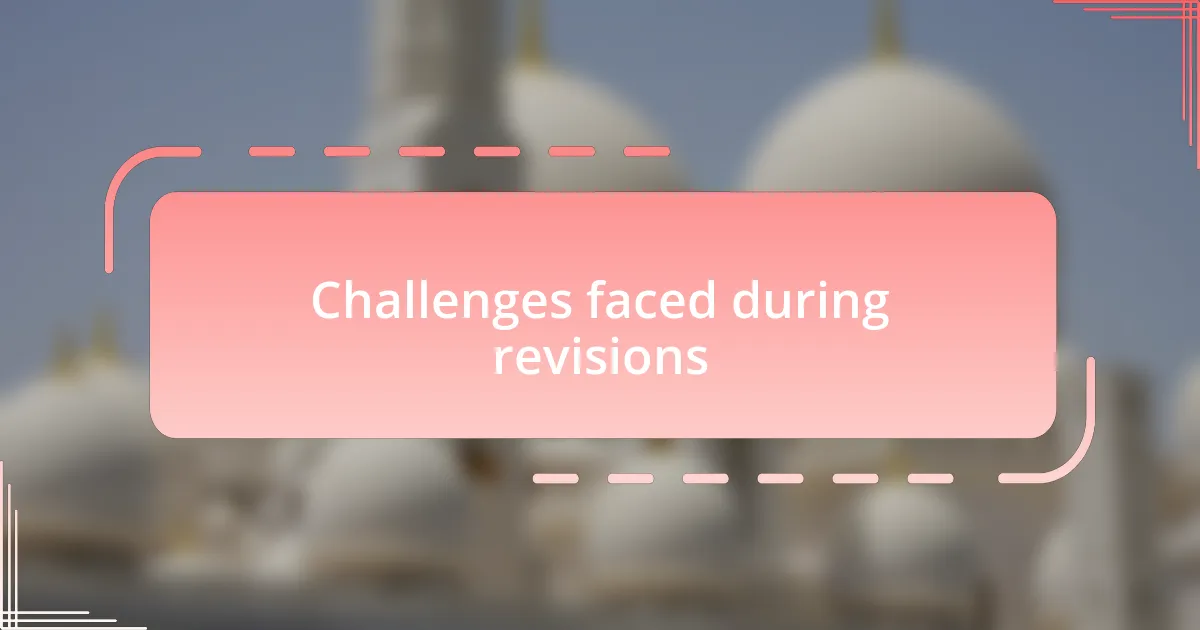
Challenges faced during revisions
Revising a curriculum is rarely a straightforward process. One major challenge I faced was pushback from colleagues who were resistant to change. Their concerns were valid, rooted in years of tradition, but navigating those conversations required patience and empathy. Have you ever tried to persuade someone about the benefits of a new approach while they held tightly to familiar methods?
Another hurdle emerged when I found that aligning the new curriculum with existing educational standards was more complicated than expected. I remember pouring over guidelines, feeling overwhelmed as I attempted to ensure that our lessons would meet these often abstract metrics. How can we maintain the integrity of our religious teachings while also meeting the demands of bureaucratic requirements?
Balancing the diverse beliefs of students also proved challenging. I recall a workshop where we brainstormed inclusive teaching strategies. While I felt inspired by the discussions, doubts crept in about whether we could truly honor every faith not just adequately but meaningfully. Isn’t it daunting to consider how to create a learning environment that respects all perspectives while fostering genuine dialogue?
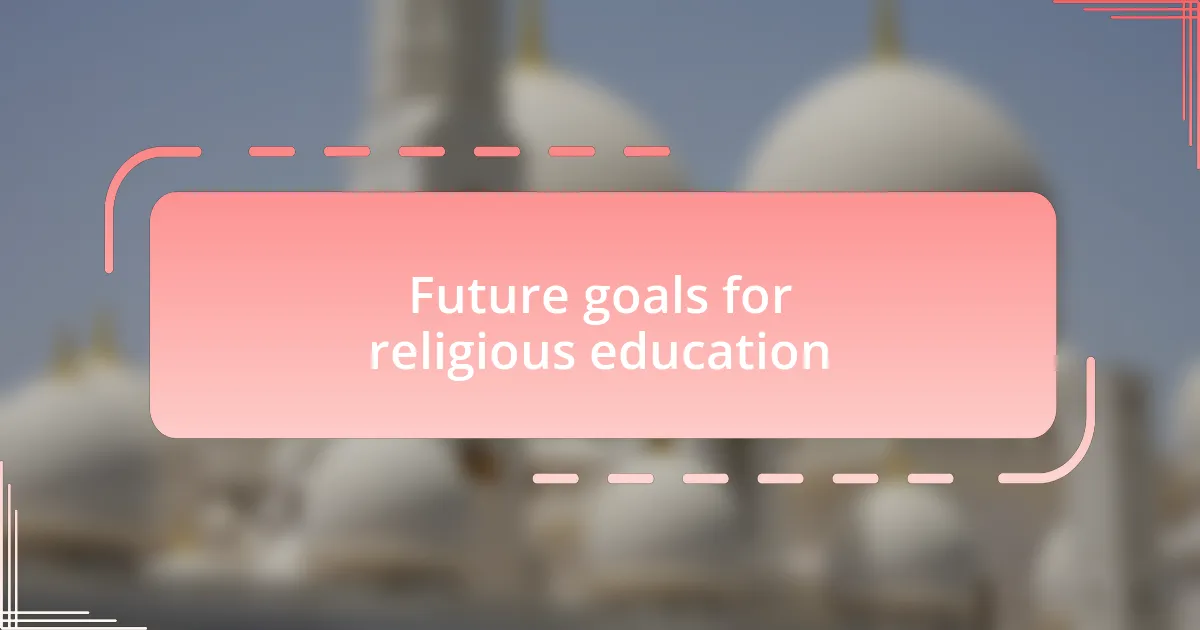
Future goals for religious education
Future goals for religious education are much more than just theoretical ideals; they reflect a commitment to fostering a deeper understanding among students. One of my aspirations is to encourage interfaith dialogue, where students can share and learn about each other’s beliefs. I often think back to a time when I facilitated a panel discussion among students of different faiths. The way they listened and responded to one another was transformative. Isn’t it important for our young people to not only learn about their own faith but also appreciate the diversity around them?
Another goal I envision is integrating modern technological tools into religious education. Imagine students using online platforms to engage with sacred texts or explore religious history through interactive maps. I have seen firsthand the enthusiasm that technology can spark in learners. Don’t you think that combining traditional teachings with innovative tools can create more dynamic and relatable learning experiences?
Lastly, fostering critical thinking about faith-related issues is paramount. I aim to challenge students to not only accept teachings but also to question and explore them deeply. I remember a particularly moving class discussion where students debated the ethical implications of certain religious practices. It was enlightening to see them grapple with complex ideas in a respectful way. Shouldn’t we encourage our future leaders to think critically and reflectively about their beliefs?